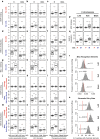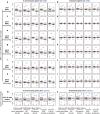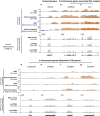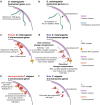Non-canonical Drosophila X chromosome dosage compensation and repressive topologically associated domains
- PMID: 30355339
- PMCID: PMC6199721
- DOI: 10.1186/s13072-018-0232-y
Non-canonical Drosophila X chromosome dosage compensation and repressive topologically associated domains
Abstract
Background: In animals with XY sex chromosomes, X-linked genes from a single X chromosome in males are imbalanced relative to autosomal genes. To minimize the impact of genic imbalance in male Drosophila, there is a dosage compensation complex (MSL) that equilibrates X-linked gene expression with the autosomes. There are other potential contributions to dosage compensation. Hemizygous autosomal genes located in repressive chromatin domains are often derepressed. If this homolog-dependent repression occurs on the X, which has no pairing partner, then derepression could contribute to male dosage compensation.
Results: We asked whether different chromatin states or topological associations correlate with X chromosome dosage compensation, especially in regions with little MSL occupancy. Our analyses demonstrated that male X chromosome genes that are located in repressive chromatin states are depleted of MSL occupancy; however, they show dosage compensation. The genes in these repressive regions were also less sensitive to knockdown of MSL components.
Conclusions: Our results suggest that this non-canonical dosage compensation is due to the same transacting derepression that occurs on autosomes. This mechanism would facilitate immediate compensation during the evolution of sex chromosomes from autosomes. This mechanism is similar to that of C. elegans, where enhanced recruitment of X chromosomes to the nuclear lamina dampens X chromosome expression as part of the dosage compensation response in XX individuals.
Keywords: Dosage compensation; Drosophila melanogaster; Lamina-associated domain; MSL complex; Topologically associated domain.
Figures







Similar articles
-
X chromosome dosage compensation via enhanced transcriptional elongation in Drosophila.Nature. 2011 Mar 3;471(7336):115-8. doi: 10.1038/nature09757. Nature. 2011. PMID: 21368835 Free PMC article.
-
X-chromosome-wide profiling of MSL-1 distribution and dosage compensation in Drosophila.Genes Dev. 2006 Apr 1;20(7):871-83. doi: 10.1101/gad.377506. Epub 2006 Mar 17. Genes Dev. 2006. PMID: 16547175 Free PMC article.
-
The right dose for every sex.Chromosoma. 2007 Apr;116(2):95-106. doi: 10.1007/s00412-006-0089-x. Epub 2006 Nov 24. Chromosoma. 2007. PMID: 17124606 Free PMC article. Review.
-
The dosage compensation system of Drosophila is co-opted by newly evolved X chromosomes.Nature. 1996 Sep 12;383(6596):160-3. doi: 10.1038/383160a0. Nature. 1996. PMID: 8774878
-
Dosage compensation and chromatin structure in Drosophila.Curr Opin Genet Dev. 1996 Aug;6(4):496-501. doi: 10.1016/s0959-437x(96)80073-6. Curr Opin Genet Dev. 1996. PMID: 8791531 Review.
Cited by
-
When Down Is Up: Heterochromatin, Nuclear Organization and X Upregulation.Cells. 2021 Dec 4;10(12):3416. doi: 10.3390/cells10123416. Cells. 2021. PMID: 34943924 Free PMC article. Review.
-
Set2 and H3K36 regulate the Drosophila male X chromosome in a context-specific manner, independent from MSL complex spreading.bioRxiv [Preprint]. 2024 May 6:2024.05.03.592390. doi: 10.1101/2024.05.03.592390. bioRxiv. 2024. Update in: Genetics. 2024 Oct 17:iyae168. doi: 10.1093/genetics/iyae168. PMID: 38766267 Free PMC article. Updated. Preprint.
-
Sex-specific variation in R-loop formation in Drosophila melanogaster.PLoS Genet. 2022 Jun 10;18(6):e1010268. doi: 10.1371/journal.pgen.1010268. eCollection 2022 Jun. PLoS Genet. 2022. PMID: 35687614 Free PMC article.
-
Set2 and H3K36 regulate the Drosophila male X chromosome in a context-specific manner, independent from MSL complex spreading.Genetics. 2024 Oct 17;228(4):iyae168. doi: 10.1093/genetics/iyae168. Online ahead of print. Genetics. 2024. PMID: 39417694
-
Rapid Evolution of Autosomal Binding Sites of the Dosage Compensation Complex in Drosophila melanogaster and Its Association With Transcription Divergence.Front Genet. 2021 Jun 14;12:675027. doi: 10.3389/fgene.2021.675027. eCollection 2021. Front Genet. 2021. PMID: 34194473 Free PMC article.
References
Publication types
MeSH terms
Substances
Grants and funding
LinkOut - more resources
Full Text Sources
Molecular Biology Databases

